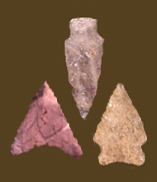
Blade: that part of a projectile point above the hafted stem area. Hafted area: the portion of a projectile point secured to a spear, dart, arrow, knife, or drill. Notch: an indentation on the sides of the blade or at the corners of the base. Native Americans notched projectile points to create a way to attach them to spears, darts, arrows, knives, or drills. Projectile Point: a bifacially-flaked tool that is used as the tip of a spear, dart, arrow, knife, or drill. Stem: hafted area of a projectile point. There are several common stem shapes:
|
![]()
Search by Shape:
(See Projectile Point Typology) |

|
Thank you for visiting our website. If you have any
questions, comments, Copyright © 2002 by |

|
